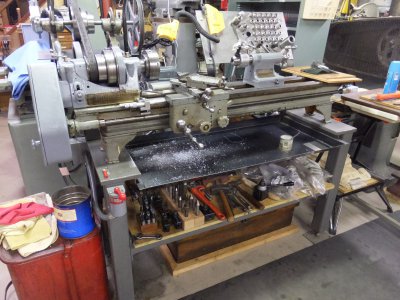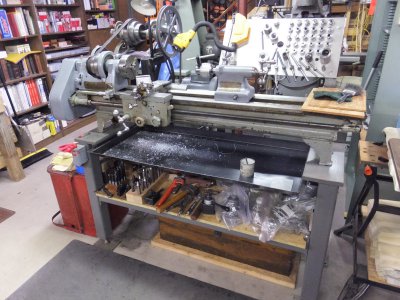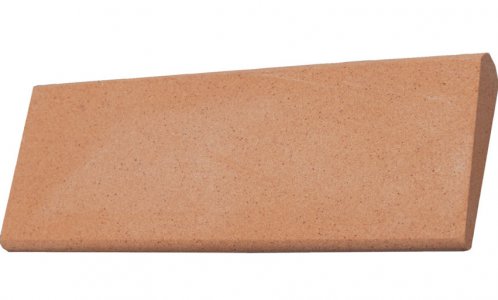hey Graham, while I got you! Do you know how to flatten Arkansas stones? Just sandpaper them? For some reason I hesitate. I have a couple nice translucents one "large" slab about 6x2, a round cone and a 3/4 x 3/4 stick which has grooves running down a couple sides maybe .005 deep. I should just sit down and paper them I guess. I'd hate to hurt em.
My apologies - I should have been clearer. I will try not to make it too long, but this post is unavoidably expansive!
I will have to think about how to make a suitable lap tool to restore cones, or round stone stuff, but this is possible. For now, let's talk about flats. Your Arkansas may need to be finished on something finer than 80 grit, but start with 120 or so, or you will be taking forever.
I first found out about how one makes (optical) flats, and exact surfaces when I first tried telescope optics making. The side knowledge gained means I have been able to pick up someting like a worn, dished 8x2x1 India stone for pre-owned cheap on eBay, and get it to totally flat like new with about 30 minutes of attention, though I admit that setup, and cleanup adds to that. Yes - even a white quartz-hard white finest Arkansas for final razor edge can be made, though those are usually smaller 5 x 2 x 3/8, and you finish with finer grits.
There is no kind of us of paper or sheet based abrasive medium that can do any better than a reasonable rough first flatness. This is simply because it has a thickness, and at the micron level, some "give". Commonly, folk will stick some abrasive paper onto a surface plate, and lap stuff. It is a bad thing to do, and it is tough to properly clean up the contamination. Use a flat metal plate, or a piece of thick plate glass instead.
When I say "flatten it", I mean moving it across a piece of plate glass that it itself supported on something reasonable flat, like a piece of counter-top. I use a chunk that was a piece of mirror. I also re-purposed a piece of thicker plate glass, about 13mm. There are only two surfaces that can slide over each other. Either it is a plane, or a part of a perfect sphere. For this, you need some abrasive.
Try eBay "Silicon Carbide Abrasive Grit". The stuff is quite cheap. You sprinkle about 1/3 teaspoon, like a few grams, onto the plate, and add about 2 drops of washing up liquid. That immediately destroys the surface tension, and it spreads. Drag a few marks in pencil across the stone, criss-cross, or squiggles. Put down on the grit and move
gently until the initial crunch has gone, and you can tell it is rolling on the abrasive. 80 grit gets you to flat faster. This kind of abrasive is (deliberately) going to break down. Do not be using diamond anythings for this. Check the pencil marks. You will see progress. It may help to have a sheet of plastic under the lot first, or do it outside.
Get used to not allowing this stuff to escape. It's safe to dispose of, even onto ground, but not in drains. It gets under nails, and into fingerprints, and can then find its way onto your machines. Use gloves. You will be washing the used up slurry aside all the time, and adding a little new abrasive. It's noisy!
BUT ..
You rapidly get to make a new stone. I am astonished how rough and jagged the lap surface can be, and still deliver fine surface stones. Some guys even find a old paving stone, or concrete block, and straighten up a badly worn or clogged wetstone. If you wash away the slurry, clean up, you can change grit to (say) 300 or 400.
If you go the whole way, through all the grit sizes, all the way to cerium oxide, or emery 303, or jewelers rouge, you end up with it mirror polished, and also useless for being a flat stone, and rubbing on anything. The curious property of (truly) flat stones is that they become incapable of actual grinding or sharpening on anything unless shown an edge at an angle. They just "slide" over the surface, showing you the polished machining marks.
In use, machinists will typically rub two stones together, before using one on a machine. Pick up good stuff from YouTube. Get to understand why a flat stone works completely differently to one used in a "sharpening" or honing action.
I would not wish to be telling you stuff you maybe already know, but you may find these interesting. If your Arkansas stone is a genuine original, then take care of it. There are no more in Arkansas!
I know Robin Renzetti used a surface grinder to make his. I made mine on a plate glass. They are mad expensive to just buy a set. For the kind of machining stuff I do, it's all I need, and may be just as good.




